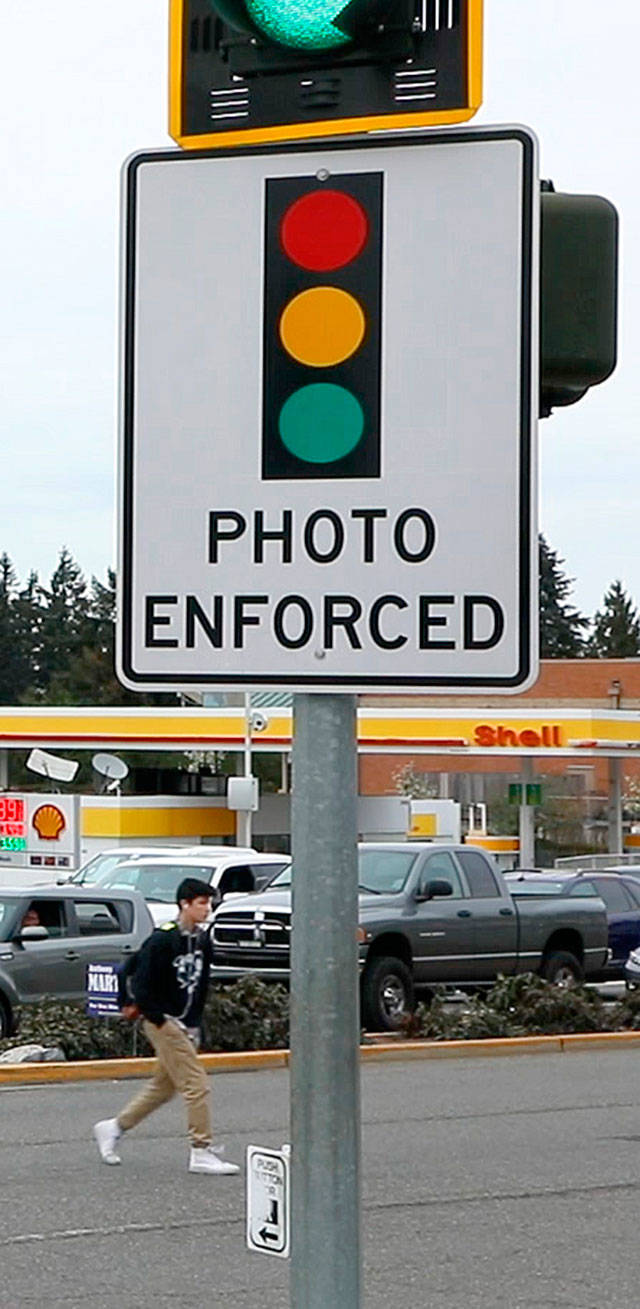Red-light cameras at six Kent intersections helped reduce the number of collisions from 143 in 2019 to 98 in 2020 — and brought in a net revenue of $2.45 million in 2020.
“Red-light cameras are working as expected,” Kent Police Chief Rafael Padilla said during a June 22 report at the Kent City Council’s virtual Committee of the Whole meeting. “Time will tell, but we continue to lower collision rates and the system is able to fund itself.”
The city installed cameras midway through 2019 at the intersections with the most collisions in response to complaints from residents about drivers running red lights. The goals were to reduce collisions and raise revenue to fund the police department’s new body-worn camera program.
Running a red light costs the owner of the vehicle $136. Kent officers review photos and videos to determine whether to issue a ticket. Kent Police picked the six intersections because those streets had the most collisions in previous years.
The number of collisions at the intersections with cameras dropped to 98 in 2020 from 143 in 2019 and 173 in 2018. There were 32 collisions through May 2021.
“There’s pretty significant difference in the numbers,” Padilla said. “There is a downward trend, and in some cases it’s pretty drastic.”
There were 20 fewer collisions in 2020 compared to 2019 at the intersection of 104th Avenue SE and SE 240th Street. There were 18 fewer collisions at 104th Avenue SE and SE 256th Street.
Padilla said the COVID-19 pandemic that hit in March 2020 could have affected numbers last year and so far this year due to reduced traffic as more people worked from home. Across the city, collisions dropped to 2,081 in 2020 compared to 2,796 in 2019.
“I am not sure we have a full year to look at,” Padilla said. “But all things being equal, we have a downward trend.”
High revenue
Red-light cameras brought in a net revenue of $2.45 million in 2020, Padilla said.
That’s the amount after the city paid Mesa, Arizona-based Verra Mobility (formerly American Traffic Solutions) about $693,000 to operate the cameras and thousands of dollars more for Kent Municipal Court staff time and pay for officers to review each violation.
Through the first five months of 2021, the program has brought in $1.1 million. In the five months the cameras operated in 2019, the city had a net revenue of $796,180.
The city uses the red-light camera revenue to fund the police department’s body-worn camera program that started in 2019. The money also funds other needs, including new police vehicles, which are also funded by school zone traffic cameras to catch speeding drivers.
The school zone cameras brought in revenue of $1.56 million in 2019, $612,824 in 2020 and $288,859 so far in 2021. The pandemic impacted school zone traffic revenue as schools were closed for part of 2020.
Kent started its school zone cameras in 2014 with revenue going to pay for police programs. The school zone camera fund brought in $1.1 million in 2018, $1.2 million in 2017, $1.1 million in 2016, $951,834 in 2015 and $927,542 in 2014.
More traffic cameras?
The council asked Padilla to look at possibly expanding the red-light camera and the school zone camera programs.
Councilmember Bill Boyce asked Padilla if any studies have been done about whether cameras are needed near more schools.
“We have not done any recent studies,” Padilla said. “It might be a good time to look at it. We can do a feasibility study.”
Councilmember Marli Larimer suggested working with the Kent School District to find out its needs with two new schools opening in the fall and boundary changes for schools that will change which schools children walk to.
Council President Toni Troutner asked Padilla to consider more red-light cameras.
“When we first had a conversation about red-light cameras, we looked at different intersections,” Troutner said. “It might be a good idea to revisit that and find out where the department feels it might be effective to add cameras. It would be a good idea to at least look at data and decide as a council whether it’s an option moving forward.”
Padilla said it also could be a good time for more traffic camera enforcement because new state laws are aimed at reducing the contact between officers and residents for lower-level crimes or violations. He also said an officer staff shortage reduces time police can spend on traffic enforcement, something cameras can do instead.
“Resources will be a challenge,” Padilla said. “It might be time to leverage automated traffic enforcement.”
Collision stats
(intersections with red-light cameras)
■ 104th Ave SE and SE 240th
2021: 11
2020: 18
2019: 38
2018: 50
2017: 36
■ 104th Ave SE and SE 256th St
2021: 5
2020: 16
2019: 34
2018: 34
2017: 41
■ 84th Ave S and S 212th St
2021: 5
2020: 18
2019: 35
2018: 35
2017: 29
■ Central Ave N and E James St
2021: 5
2020: 17
2019: 17
2018: 24
2017: 17
■ Central Ave N and E Smith St
2021: 2
2020: 9
2019: 12
2018: 15
2017: 23
■ Kent Des Moines Road and
Pacific Highway South
2021: 2
2020: 9
2019: 12
2018: 15
2017: 15
Note: 2021 stats through May.
Source: Kent Police Department
Talk to us
Please share your story tips by emailing editor@kentreporter.com.
To share your opinion for publication, submit a letter through our website https://www.kentreporter.com/submit-letter/. Include your name, address and daytime phone number. (We’ll only publish your name and hometown.) Please keep letters to 300 words or less.

